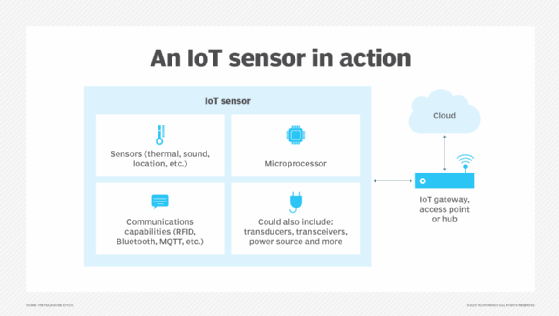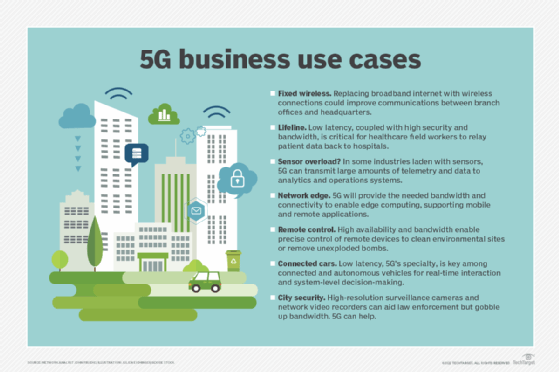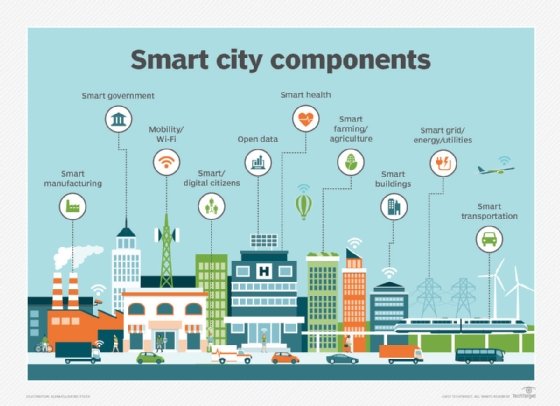What is a smart city?
A smart city is a municipality that uses information and communication technology to increase operational efficiency, share information with the public, and improve the quality of government services and citizen welfare.
While the exact definition varies, the overarching mission of a smart city is to optimize city functions, drive economic growth, and improve the quality of life for its citizens using technology and data analysis. Value is given to the smart city based on what it chooses to do with the technology, not just how much technology it may have.
Smart city initiatives usually require three major hallmarks, as previously defined by the U.S. Department of Transportation:
- Networks of sensors and citizens to collect data.
- Connectivity from the networks, data and citizens to the government.
- Open data to share the results, changes, improvements and data fairly to the public.
Additionally, smart city programs often intersect with other municipal priorities. Several major characteristics are used to evaluate a city's relative "smartness." These characteristics may include the following:
- Technology-based infrastructure.
- Environmental initiatives.
- High-functioning public transportation system.
- Confident sense of urban planning.
- Humans to live and work in the city and use its resources.
A smart city's success depends on its ability to form a strong relationship among the government, the private sector and its citizens. This relationship is necessary because most of the work done to create and maintain a digital, data-driven environment occurs outside the government. For example, surveillance equipment for busy streets could include sensors from one company, cameras from another and a server from yet another, with the data fed back to the government agency that then acts on it.
Additionally, independent contractors may be hired to analyze the data, which is then reported back to the city government. This data could then lead to engaging an application development team to try to address problems found in the analyzed data. This company could become part of the system if the solution requires regular updating and management. A smart city's success becomes more focused on building positive relationships than on completing a single project.
For a smart city initiative to succeed, it must use the data collected to make better decisions. Imagine all a city's buses being equipped with sensors on the suspension. This data could be used in route planning to reduce underused routes and alleviate overloaded ones. The shock data could also be combined with the bus's Global Positioning System location and fed to road maintenance crews to find and remediate the worst potholes.
Smart city technology
Smart cities use a combination of internet of things (IoT) devices, software solutions and communication networks. However, they rely first and foremost on IoT, which is a network of connected devices, such as vehicles, sensors or home appliances, that can communicate and exchange data. Servers on the cloud store data from the IoT sensors and devices.

The connection of these devices and use of data analytics facilitate the convergence of the physical and digital city elements, improving both public and private sector efficiency, enabling economic benefits and improving citizens' lives.
When the IoT devices include edge computing capabilities, it's possible to preprocess the data and take simple actions, ensuring that only the most important, relevant information is communicated over the network.
Modern 5G networks can be used to connect IoT devices. 5G greatly increases the reliability and capacity of the data networks. This allows for more sensors and greater amounts of collected data.

Proper security is also vital in a smart city. Since much of a city's vital infrastructure is connected to the internet, it opens it up to cyberattack. If not properly secured, data could be stolen, ransomware could cripple operations, equipment could be damaged or lives could be lost if critical services go offline.
Other smart city technologies include the following:
- application programming interfaces.
- artificial intelligence.
- cloud computing.
- dashboards.
- machine learning (ML).
- machine-to-machine.
- mesh network.
- digital twin.
Features of a smart city
In addition to IoT, emerging trends, such as automation and ML, are driving smart city adoption.
Theoretically, any area of city management can be incorporated into a smart city initiative. A classic example is the smart parking meter, which uses a mobile application to help drivers find available parking spaces without prolonged circling of crowded city blocks. The smart meter also enables digital payment.
Also, in the transportation arena, smart traffic management is used to monitor and analyze traffic flows to optimize streetlights and prevent roadways from becoming too congested based on time of day or rush-hour schedules. Public transit is another smart city focus. Smart transit companies can coordinate services and fulfill riders' needs in real time, improving efficiency and rider satisfaction. Ride-sharing and bike-sharing are also common smart city services.
Energy conservation and efficiency are major objectives of smart cities. Using smart sensors, smart streetlights dim when there aren't cars or pedestrians on roadways. Smart grid technology can improve operations, maintenance and planning; supply power on demand; and monitor energy outages. As more renewable energy sources join the power grid, smart grid technologies can help to regulate power use.
Smart city initiatives also aim to monitor and address environmental concerns, such as climate change and air pollution. Smart technology, including internet-connected trash cans and IoT-enabled fleet management systems, can enhance waste management and sanitation. Sensors can measure and guarantee the quality of drinking water at the front end of the system, with proper wastewater removal and drainage at the back end.

Smart city technology is increasingly being used to improve public safety, from monitoring areas of high crime to improving emergency preparedness with sensors. For example, smart sensors can be critical components of a system providing early warnings before droughts, floods, landslides or hurricanes. Some cities have systems to detect and locate gunshots.
Smart buildings are also often part of a smart city project. Legacy infrastructure can be retrofitted and new buildings constructed with sensors to facilitate real-time space management, ensure public safety and monitor the structural health of buildings. Sensors can detect wear and tear and notify officials when repairs are needed. Citizens can help in this matter, notifying officials through a smart city application when repairs are needed in buildings or for other public infrastructure, like potholes. Sensors can also detect leaks in water mains and other pipe systems, helping prompt timely repairs and reduce costs.
Smart city technologies also bring efficiencies to urban manufacturing and farming, creating jobs, saving energy and space, and giving consumers fresher goods.
How a smart city works
Smart cities use their web of connected IoT devices and other technologies to achieve their goals, typically following four steps:
- Collection. Smart sensors throughout the city gather data in real time.
- Analysis. Data collected by the smart sensors is assessed to draw meaningful insights.
- Communication. The insights found in the analysis phase are communicated with decision-makers through strong communication networks.
- Action. Cities use the insights to create solutions, optimize operations and asset management, and improve the quality of life for residents.
Fostering sustainability with smart cities
Sustainability is another target for smart cities. The United Nations reported that around 55% of the world's population currently resides in an urban area or city; this figure is set to rise to 68% throughout the coming decades. Smart technology will help cities sustain growth and improve efficiency for citizen welfare and government efficiency in urban areas.
Smart city technologies could alleviate the environmental impact of municipal emissions, such as those from fossil fuels. Switching to an electric public transportation system can decrease fuel emissions. Cities can also alter the electric power infrastructure to minimize the impact of charging batteries during peak hours of electric use. With proper coordination, electric vehicles, when not in service, could also regulate the frequency of the city's electric grid.
The number of cars used is likely to decrease as municipalities become smarter. Autonomous vehicles, or self-driving cars, could potentially change a population's perspective on the necessity of owning cars. The adoption of autonomous vehicles is expected to reduce the amount of vehicles civilians own, decreasing the number of cars on the street and further lowering the emission of detrimental gases.
Smart city challenges and concerns
Smart city initiatives must include the people they aim to help: residents, businesspeople and visitors. City leaders must raise awareness of the benefits of smart city technologies being implemented and promote the use of open, democratized data to its citizens. If people understand the benefits of what they're participating in, they are more likely to engage.
Fostering collaboration between the public and private sector and city residents is key to creating a smart citizen who is engaged and empowered to contribute positively to the city and community. Smart city projects should include plans to make data transparent and available to citizens, often through an open data portal or mobile app. This enables residents to engage with the data and understand its use. Through a smart city app, residents may be able to complete personal chores, such as viewing their home's energy consumption, paying bills and finding efficient public transportation.
Smart city opponents worry that city managers will not keep data privacy and security top of mind; they fear exposure of the data that citizens produce on a daily basis to the risk of hacking or misuse. Additionally, the presence of sensors and cameras may be perceived as an invasion of privacy or government surveillance. To address this, smart city data collected should be anonymized and not contain personally identifiable information.
However, the biggest challenge smart cities face is connectivity. The thousands or millions of IoT devices scattered across the city would be useless without a solid connection, and the smart city itself would be dead.
Public transit, traffic, public safety, water and waste, electricity and natural gas management can be unreliable, especially as a system ages and grows. However, the importance of these operations will only increase as the city expands and demands on its infrastructure increase. These systems must be constantly maintained and tested to ensure their proper functioning.
Newly built smart cities are also challenged by finding ways to attract and keep residents without a cultural fabric. An area's cultural essence is often what attracts residents the most; this cannot be programmed or controlled with a sensor. Therefore, planned smart cities may falter because they cannot provide a sense of authenticity, distinctiveness or place.
Some smart cities being built from the ground up -- like Saudi Arabia's Neom -- lack an established population and must recruit residents. Neom is being built with no past success to provide confidence about generating growth, and concerns have risen over whether there are even sustainable water sources available.
Why we need smart cities
The primary goal of a smart city is to create an urban environment that yields a high quality of life to its residents, while also generating overall economic growth. A major advantage of smart cities is their ability to deliver more and better services to citizens with less infrastructure and cost.
As the population within cities continues to grow, it becomes necessary for these urban areas to accommodate growth with more efficient use of their infrastructure and assets. Smart city applications can satisfy that need, helping cities derive new value from existing infrastructure. Making smart city improvements can be a great investment that ushers in new revenue streams, while creating operational efficiencies that save money.
Examples of smart cities
While many cities across the world have started implementing smart technologies, a few stand out as the furthest ahead in development. These cities include the following:
- Kansas City, Missouri.
- San Diego, California.
- Columbus, Ohio.
- New York City, New York.
- Toronto, Canada.
- Singapore.
- Vienna, Austria.
- Barcelona, Spain.
- Tokyo, Japan.
- Reykjavik, Iceland.
- London, U.K.
- Melbourne, Australia.
- Dubai, United Arab Emirates.
- Hong Kong, China.
Most of the major smart city projects are concentrated in the Middle East and China, but in 2018, Reykjavik and Toronto were listed alongside Tokyo and Singapore as some of the world's smartest cities.
Often considered the gold standard of smart cities, the city-state of Singapore uses sensors and IoT-enabled cameras to monitor the cleanliness of public spaces, crowd density and the movement of locally registered vehicles. Its smart technologies help companies and residents monitor energy use, waste production and water use in real time. Singapore is also testing autonomous vehicles, including full-size robotic buses, as well as a health monitoring system to ensure the well-being of its senior citizens.
Kansas City has implemented smart streetlights, interactive kiosks and more than 50 blocks of free public Wi-Fi along its two-mile streetcar route. The city's data visualization app publicly displays parking spaces, traffic flow and pedestrian hotspots.
San Diego installed 3,200 smart sensors in early 2017 to optimize traffic and parking, enhance public safety, foster environmental awareness and boost overall quality of life for its residents. Solar-to-electric charging stations are available to empower electric vehicle use, and connected cameras help monitor traffic and pinpoint crime.
In Dubai, smart city technology supports traffic routing, parking, infrastructure planning and transportation. The city also uses telemedicine and smart healthcare, smart buildings, smart utilities, smart education and smart tourism.
In Barcelona, smart transportation and bus systems complement smart bus stops that provide free Wi-Fi, USB charging stations and bus schedule updates for riders. A bike-sharing program and smart parking app include online payment options. The city also uses sensors to monitor temperature, pollution, noise, humidity and rain levels.
History of the smart city
The concept of the smart city dates to the 1960s and 1970s when the Community Analysis Bureau in Los Angeles started using computer databases, cluster analysis and infrared aerial photography to collect data, issue reports and direct resources to the areas that need them most to fight off potential disasters and reduce poverty. Since then, three different generations of smart cities have emerged.
Technology providers led Smart City 1.0. This generation focused on implementing technology in cities despite the municipality's inability to fully understand the possible implications of the technology or the effects it may have on daily life.
In contrast, cities led Smart City 2.0. Here, forward-thinking leaders helped determine the future of the city and how smart technologies and other innovations could be deployed to create it.
In the third generation, Smart City 3.0, neither technology providers nor city leaders have exclusive control; instead, a citizen co-creation model has emerged. Achieving equity and a smart community with social inclusion seems to have inspired this evolution.
Vienna is one of the first cities to adopt this new, third-generation model. There, a partnership has been formed with a local energy company called Wien Energie. As part of it, Vienna included citizens as investors in local solar plants. Vienna has also highlighted citizen engagement in resolving issues such as gender equality and affordable housing.
Smart cities can make residents' lives easier through real-time traffic information and public safety alerts. However, governments should be aware of how to manage use cases effectively. Learn how IoT data provides a foundation for smart city use cases.




